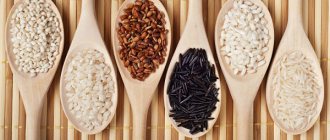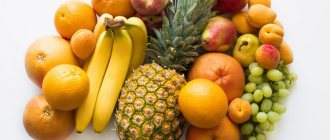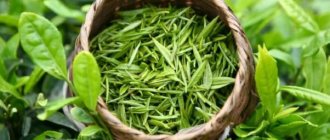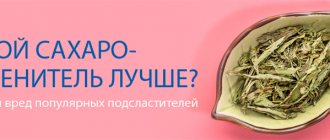Gardening » Citrus » Mandarin
0
2288
Article rating
Kira Stoletova
Tangerines are useful for diabetes. Fruits contain a large amount of vitamins and nutrients that contribute to better functioning of the body. This citrus does not affect the percentage increase in blood glucose.
Tangerines for diabetes
Composition of fruits and benefits for illness
Is it possible to eat tangerines if you have diabetes and what are the benefits of orange fruits? Diabetes mellitus is a pathology associated with an absolute or partial deficiency of the hormone insulin. In this regard, carbohydrate metabolism is disrupted, which leads to an increase in glucose levels in the body. People with diabetes should not eat foods that cause a rapid increase in blood sugar. If you are ill, it is not advisable to eat fruits such as grapes, very ripe bananas, strawberries, and apricots. In contrast, tangerines, even very ripe ones, are not capable of causing harm to the diabetic body. Fruits contain easily digestible glucose and fiber. Due to them, glucose dissolves slowly, which helps prevent a sharp increase in blood sugar concentration.
Diabetics need to be careful about their health. Constant surges in glucose negatively affect the condition of internal organs and blood vessels. Thanks to their unique composition, tangerines help improve health and boost immunity.
Benefits of citrus fruits for diabetes:
- In addition to the beneficial vitamin C, which is found in large quantities in citrus fruits, tangerines contain vitamins D, B1, K and K2. These microelements are well preserved in orange fruits even in winter, stabilize the functioning of the heart and blood vessels, which suffer greatly when the functioning of the pancreas is impaired;
- Tangerines contain citric acid, which helps remove nitrates and other harmful components from the body. This is especially useful for older diabetics;
- Citrus juice is an excellent antiseptic. For various lesions of the dermis, which affect a large number of people with diabetes, it is simply irreplaceable;
- the use of tangerines as a dietary supplement helps prevent the formation of cholesterol plaques, which significantly reduces the threat of developing atherosclerosis and stroke;
- the refreshing pulp of citrus fruits helps cope well with thirst, the fruit is suitable for replacing desserts, has a pleasant refreshing taste with a sweet and sour tint;
- the essential oils contained in tangerines are an excellent prevention of stress and bad mood;
- Phytoncides contained in fruit pulp help improve the functioning of the digestive system and prevent thrush;
- Another component - the amino acid synephrine - helps overcome asthma, bronchitis, relieves swelling, and has an expectorant effect.
Tangerines are extremely beneficial for the body of both healthy people and diabetics
Despite being very low in calories, sunny fruits can provide almost all vital nutrients to a person. A small fruit contains about 20 mg of vitamin C and 100 - 150 mg of potassium. These components help normalize the functioning of the entire body, improve immunity, and prevent the negative consequences of diabetes.
Important! When eating orange fruits, it is better not to completely remove the white mesh. It contains glycosides that have a beneficial effect on the body from the inside.
Beneficial features
Tangerines contain potassium and vitamin C. Potassium improves the functioning of the heart and cardiovascular system. Vitamin C improves immunity, the body becomes more hardened to resist infections.
This fruit has a number of advantages:
- blood pressure is normalized;
- the body is in good shape;
- glucose is broken down more slowly, then the risk of a sharp increase in sugar is minimized;
- the functioning of the gastrointestinal tract improves;
- citrus removes toxins and excess liquid well;
- due to the content of vitamins, the body fights diseases better;
- Helps avoid obesity and atherosclerosis.
With or without peel
Is it possible to eat tangerines with type 2 diabetes with the peel and what are the benefits of the peels? Many people are accustomed to eating only the pulp, completely removing the peel and white mesh from the fruit, but not many people know that it is the peel that contains the greatest amount of fiber. In addition, the peel helps cope with colds and infectious diseases. Tangerine peels contain pectins, which are essential for the normal functioning of the intestines, and polysaccharides, which remove heavy metals and other negative elements from the body.
Tangerines for type 2 diabetes: how many per day
For type 1 and type 2 diabetes, tangerines can be included in the daily diet; eating 2-3 medium-sized fruits will be safe. It is advisable to use citrus fruits as a snack between breakfast and lunch or as a dessert after a daily meal. As a dinner, tangerines are best consumed as part of complex dishes, for example, adding them to a mixture for cottage cheese casserole.
Decoction of peels
A decoction of tangerine peels is very useful for all types of diabetes. In addition to preventing diabetes, regularly eating orange fruits with peel helps prevent skin cancer and many other diseases. Citrus fruits contain magnesium, phosphorus, potassium, vitamins C, D, K, essential oils, flavones and many other components.
To prepare the decoction you will need the following products:
- 5 peeled tangerines;
- sweetener;
- a pinch of cinnamon;
- 3 – 4 teaspoons zest;
- 10 ml freshly squeezed lemon juice.
Place tangerines in 1–1.5 liters of boiling water, after dividing them into slices. The broth should be simmered over low heat for about 10 minutes. After this, add the zest, cinnamon and lemon juice, and boil again for 3-5 minutes. Add the sweetener to the slightly cooled broth and mix the drink thoroughly. It is recommended to take the resulting medicine after meals, 2-3 teaspoons. You can add the decoction to tea, plain water, and unsweetened juices. Regular use of this product helps to improve immunity and stabilize the functioning of all vital systems.
Tangerine peels contain a huge amount of microelements and vitamins
Tangerines are classified as seasonal fruits; they cannot be purchased at any time of the year, so it is recommended to stock up on peels to use a decoction of them in summer and spring. To stock up on raw materials, just peel the fruit and dry the peel in the fresh air. It is better to store crusts in fabric bags or paper. Fresh crusts should be prepared every year.
Recipes
You can include some dishes with tangerine in your diet.
Diabetic salad
Ingredients:
- 200 g tangerine slices,
- 30–40 pomegranate seeds,
- 15 blueberries (cranberries or cherries),
- 1/4 ripe banana
- 1/2 fresh chopped apple.
Mix the ingredients and season with kefir or natural yogurt. Use the dish fresh; storing it in the refrigerator is not advisable.
Tangerines contain a lot of water, but they also help remove excess fluid from the body. The fruits prevent swelling and reduce the symptoms of hypertension.
Homemade jam without sugar
Ingredients:
- 1 kg tangerines,
- 1 kg of sorbitol or 400 g of glucose
- 250 ml water.
Recipe:
- Remove the skin and white veins from the tangerines.
- Cut the pulp into slices and the zest into thin strips.
- Fill with water and cook for 40 minutes over low heat. This time is enough to soften the zest.
- Cool the mixture and grind with a blender.
- Add sweetener and return to low heat until it comes to a boil.
The jam can be consumed after preparation, when it has cooled. To preserve the product for the winter, transfer it to jars while still hot and close the lid tightly. Store in the refrigerator.
How to properly introduce fruits into your diet
How to eat tangerines correctly if you have type 2 diabetes? Despite the enormous benefits for the body, even tangerines will not bring the desired effect if they are not eaten correctly in case of diabetes. People with diabetes should remember the need for fractional meals. Food intake is carried out 4-5 times throughout the day in small portions.
It is recommended to eat fruits in case of pancreatic pathology according to the following scheme:
- During breakfast, the patient can eat a quarter of the daily calorie intake. It is better if breakfast takes place at the same time;
- A few hours after breakfast you can have a snack. It is at this time that you can eat 1 large or 2 medium tangerines. Fruits can be part of a salad, casserole, or act as an independent dish. The second breakfast should consist of 15% of the daily calorie intake;
- It is recommended to consume a third of the daily calorie intake for lunch;
- During dinner, the patient should eat the remaining calories. Dinner and a snack before bed should be light; low-fat fermented milk products, salads, fruits, and vegetables are good for this.
If desired, a diabetic can eat one fruit at lunch and evening or only in the evening. You should not eat tangerines in the form of syrup or canned food. Such dishes will lead to a jump in glucose, which is extremely undesirable for diabetes. You should not drink tangerine juice, because it replaces fructose with sucrose, the use of which is unacceptable if you have a disease of the endocrine system.
Important! In addition to the great benefits for the body, fruits can cause the development of an allergic reaction, so you should not eat fruits in large quantities.
Epidemiology of diabetes
Diabetes is associated with complications in many organic systems, the most obvious of which is loss of vision. The most common complications affect the peripheral and autonomic nervous systems. Patients with diabetes are 15 times more likely to develop hypertension and other associated pathologies. For many, the incidence of infections increases and the rate of wound healing decreases. The main symptoms of diabetes are excessive urine output (polyuria), abnormal increase in nutritional needs (polyphagia), increased thirst (polydipsia) and weight loss for no apparent reason.
Polydipsia
Estimates from health insurance data showed that the incidence of diabetes in the general population increased from 1989 to 2007 from 5.9% to 8.9%. This increase is mainly due to the increasing prevalence of type 2 diabetes.
Diabetes is more common among older people than among younger people: whereas in the age group 40-59 years, only about 4-10% had diabetes. Approximately 15,000 children and adolescents under the age of 14 have type 1 diabetes. Between 2,100 and 2,300 new cases are reported annually in this age group. Several studies have demonstrated an increase in the incidence of type 1 diabetes of 3-4% per year. In 2010, approximately 32,000 patients under the age of 20 were living with type 1 diabetes.
Type 1 can appear for the first time at any age. Globally, 65,000 new cases are reported annually and the annual growth rate is estimated at 3%.
The country with the highest incidence of diabetes is Finland. However, the number of new cases among adolescents under 15 years of age has not yet increased, at least not in the last 15 years. Researchers attribute this to the addition of vitamin D to milk.
Contraindications
Scientists have proven that tangerines provide excellent prevention of type 1 and type 2 diabetes and have a beneficial effect on all human systems and organs in cases where the disease has already developed. But not all patients can introduce these sweet and sour fruits into their diet without harm to health. Citrus fruits are contraindicated in the following conditions:
- diseases of the digestive system. For ulcers, gastritis and other diseases of the stomach and intestines, it is better to avoid tangerines. Diabetics often suffer from diseases of the digestive system, so before introducing fruits into the diet, you should definitely consult your doctor;
- Fruits should be consumed very carefully if you have liver diseases, hepatitis and others. Such people can eat no more than a slice per day after the doctor’s permission;
- Tangerines are strictly prohibited for nephritis. This disease occurs quite often in diabetics. Due to frequent urination, the load on the kidneys increases greatly. Eating tangerines will only worsen the situation;
- Another contraindication is the presence of allergies. After eating citrus fruits, many people develop rashes on their bodies, nasal breathing becomes difficult, and tearing appears. Before eating fruits, it is better to conduct allergy tests.
Excessive consumption of tangerines provokes allergies and other negative consequences
Compliance with all recommendations and taking into account contraindications will help prevent negative consequences that may arise from consuming tangerines.
Compound
Tangerines are a thermophilic species that is most resistant to drought and cold. Old plants usually survive down to -9°C, even if they lose some of their leaves. The soil in which they grow may not be very rich in nutrients, but it must be moist. Tangerines are smaller evergreen trees that usually grow up to 4-6 m and have thin branches. The flowers contain a lot of nectar and are often visited by pollinating bees.
The fruit is called a hesperidium, which is a modified berry. When ripe, the fruit becomes bright orange or red, aromatic, juicy and sweet. The mesocarp is thin and has no central column. The fruit contains numerous, ovoid, about 1 cm large seeds with a rounded base.
Mandarin is a citrus fruit and has been cultivated in China for several thousand years. In 1805, it arrived in Europe and to this day has developed into a fruit that has become indispensable in autumn and winter. From October to January is tangerine season. The fruit is considered very valuable due to its high vitamin C content.
Important! According to recent studies, hesperidin contained in citrus fruits may have a weak hypoglycemic effect: this is important to consider when administering insulin. If no more than 5-10 tangerines are taken per day, as a rule, the hypoglycemic effect is not noticeable and not so significant, so insulin adjustments will not be required. It is important not to overuse fruits.
Hesperidin
Mandarin is one of the sweetest fruits that has a low amount of calories. Clementines were developed by crossing a mandarin orange with an orange.
A tangerine weighs about 50 grams. Nutritional value per 100 grams of tangerines:
- 210 kJ;
- 1 g protein;
- 0.25 g fat;
- 10 g carbohydrates.
Tangerines are also sold as canned fruit in the supermarket. It is better for diabetic patients to avoid canned food options as they contain a lot of sugar.
Tangerines contain a lot of vitamin C. From 100 grams you can get 40 percent of an adult's daily requirement for ascorbic acid. 100 grams – about 2 pieces. Patients who eat five tangerines meet their vitamin C needs throughout the day.
The fruit also contains potassium, calcium and magnesium. The fibers between individual cuts, as well as the skins, contain pectins.
In recent studies, which until now have only been done on mice, scientists from Canada have discovered a substance in mandarin orange that has a lipid-lowering effect - nobiletin. Nobiletin reduced blood glucose and lipid concentrations in in vitro studies. Unfortunately, the research has so far only been successfully performed on mice. Tangerine has more sugar than other citrus fruits.
Nobiletin
How to choose the right one
The quality of the fruit can be determined by its appearance and the condition of the peel.
Rules for choosing ripe and healthy tangerines:
- The fruit should be firm with elastic skin. A good ripe fruit quickly regains its shape after pressing.
- The surface of the peel should be clean, smooth, without stains or other signs of deterioration. If it is sticky and shiny, it means that chemicals were used to treat the fruit.
- Fruits should not be eaten if there is mold on the surface.
- The tangerine should be uniform in color: the darker, the sweeter the fruit.
- The ripeness of fruits is also determined by their shape - ripe fruits are slightly flattened.
We recommend that you familiarize yourself with the habitat of pine trees
What to consider with tangerines for gestational diabetes in pregnant women
Tangerines can be consumed in pregnant women with gestational diabetes, but it must be taken into account that during the period of bearing a child, a woman’s sensitivity to any irritants increases, which can “result” in severe allergies. Citrus fruits are a priori hyperallergenic products, so you need to take into account the following nuances:
- Does the pregnant woman have a history of allergies?
- how the body previously reacted to familiar foods;
- What is the severity of gestational diabetes?
The best option is to consult a gynecologist and endocrinologist. If there is no opportunity to talk with a specialist, then a pregnant woman diagnosed with gestational diabetes should begin to introduce tangerines into the menu in minimal doses - eat ½ slice and wait several hours to assess her condition. If there are no signs of classic allergies, then you can gradually increase the amount of fruit.










